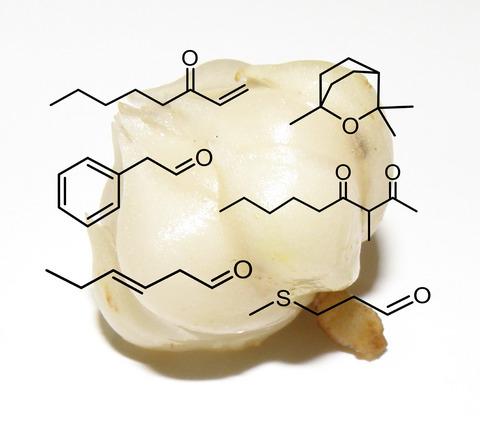当前位置:
X-MOL 学术
›
Flavour Frag. J.
›
论文详情
Our official English website, www.x-mol.net, welcomes your feedback! (Note: you will need to create a separate account there.)
Identification of key aroma compounds in raw and roasted lily bulbs (Bai He)
Flavour and Fragrance Journal ( IF 2.6 ) Pub Date : 2018-03-14 , DOI: 10.1002/ffj.3446 Nancy Chiang 1 , Chi Tang Ho 1 , John P. Munafo 2
Flavour and Fragrance Journal ( IF 2.6 ) Pub Date : 2018-03-14 , DOI: 10.1002/ffj.3446 Nancy Chiang 1 , Chi Tang Ho 1 , John P. Munafo 2
Affiliation

|
Lily bulbs (Lilium longiflorum Thunb.), known as ‘Bai He’ in Chinese, are a popular ingredient used in Asian cooking. Despite their popularity, little is known about the odorants responsible for their distinct aroma. The key aroma‐active compounds present in both raw and roasted lily bulbs were isolated by solvent extraction followed by solvent‐assisted flavour evaporation (SAFE) and gas chromatography–olfactometery (GC/O) analysis. A comparative aroma extract dilution analysis (cAEDA) in the flavour dilution (FD) factor range from ≥1 to 1024 resulted in 48 aroma‐active compounds reported in L. longiflorum bulbs for the first time. The highest FD factors in raw lily bulbs were determined for (E)‐hex‐3‐enal (green, FD 1024) and 3‐methylsulfanylpropanal (cooked potato‐like, FD 1024), followed by 2,2,4‐trimethyl‐3‐oxabicyclo[2.2.2]octane (eucalyptus‐like, FD 256) and 2‐phenyl acetaldehyde (floral, FD 256). Following roasting, odorants with high FD values in raw lily bulbs decreased in intensity. The thermal treatment resulted in the generation of 34 aroma‐active compounds. Aroma‐active compounds with FD factors of ≥1024 in roasted lily bulbs were identified as 1‐(3,4‐dihydro‐2H‐pyrrol‐5‐yl)ethan‐1‐one (roasty), 3‐methylsulfanylpropanal (cooked potato‐like), 2‐ethyl‐3,5‐dimethylpyrazine (earthy), 2,3‐diethyl‐5‐methylpyrazine (earthy), 3‐hydroxy‐4,5‐dimethyl‐2(5H)‐furanone (maple‐like), 2‐ethyl‐4‐hydroxy‐3‐methyl‐2H‐furan‐5‐one (maple‐like), and 2‐methoxy‐4‐[(E)‐prop‐1‐enyl]phenol (clove‐like). In summary, the aroma‐active compounds with high FD factors in raw lily bulbs decreased significantly as a result of roasting, and a new pool of aroma‐active compounds were formed during the roasting process.
中文翻译:

鉴定生百合和烤百合鳞茎中的主要香气化合物(白鹤)
百合鳞茎(Lilium longiflorum Thunb。)在中文中被称为“白鹤”,是亚洲烹饪中常用的配料。尽管它们很受欢迎,但对于引起其独特香气的增香剂知之甚少。通过溶剂萃取,溶剂辅助风味蒸发(SAFE)和气相色谱-比色法(GC / O)分析分离出生百合和烤百合球中存在的关键香气活性化合物。香精稀释度(FD)因子范围从≥1到1024的对比香精提取物稀释度分析(cAEDA)首次在长寿花球茎中报告了48种香气活性化合物。确定了(E)原始百合球茎中的最大FD因子)十六进制的3-烯醛(绿色,FD 1024)和3-甲基硫烷基丙醛(煮的马铃薯样,FD 1024),然后是2,2,4-三甲基-3-氧杂双环[2.2.2]辛烷(类似桉树) ,FD 256)和2-苯基乙醛(花香,FD 256)。烘烤后,生百合球中FD值高的气味强度降低。热处理导致生成34种香气活性化合物。烤百合球中FD系数≥1024的芳香活性化合物被鉴定为1-(3,4-二氢-2H-吡咯-5-基)乙-1(烘烤),3-甲基硫烷基丙醛(煮熟的马铃薯)例如),2-乙基-3,5-二甲基吡嗪(土),2,3-二乙基-5-甲基吡嗪(土),3-羟基-4,5-二甲基-2(5H)-呋喃酮(类似枫树) ,2-乙基-4-羟基-3-甲基-2H呋喃-5-酮(类似枫树)和2-甲氧基-4-[[(E)-丙-1-烯基]苯酚(丁香状)。总之,由于焙烧,生百合球中具有高FD因子的芳香活性化合物显着减少,并且在焙烧过程中形成了新的芳香活性化合物库。
更新日期:2018-03-14
中文翻译:

鉴定生百合和烤百合鳞茎中的主要香气化合物(白鹤)
百合鳞茎(Lilium longiflorum Thunb。)在中文中被称为“白鹤”,是亚洲烹饪中常用的配料。尽管它们很受欢迎,但对于引起其独特香气的增香剂知之甚少。通过溶剂萃取,溶剂辅助风味蒸发(SAFE)和气相色谱-比色法(GC / O)分析分离出生百合和烤百合球中存在的关键香气活性化合物。香精稀释度(FD)因子范围从≥1到1024的对比香精提取物稀释度分析(cAEDA)首次在长寿花球茎中报告了48种香气活性化合物。确定了(E)原始百合球茎中的最大FD因子)十六进制的3-烯醛(绿色,FD 1024)和3-甲基硫烷基丙醛(煮的马铃薯样,FD 1024),然后是2,2,4-三甲基-3-氧杂双环[2.2.2]辛烷(类似桉树) ,FD 256)和2-苯基乙醛(花香,FD 256)。烘烤后,生百合球中FD值高的气味强度降低。热处理导致生成34种香气活性化合物。烤百合球中FD系数≥1024的芳香活性化合物被鉴定为1-(3,4-二氢-2H-吡咯-5-基)乙-1(烘烤),3-甲基硫烷基丙醛(煮熟的马铃薯)例如),2-乙基-3,5-二甲基吡嗪(土),2,3-二乙基-5-甲基吡嗪(土),3-羟基-4,5-二甲基-2(5H)-呋喃酮(类似枫树) ,2-乙基-4-羟基-3-甲基-2H呋喃-5-酮(类似枫树)和2-甲氧基-4-[[(E)-丙-1-烯基]苯酚(丁香状)。总之,由于焙烧,生百合球中具有高FD因子的芳香活性化合物显着减少,并且在焙烧过程中形成了新的芳香活性化合物库。



























 京公网安备 11010802027423号
京公网安备 11010802027423号